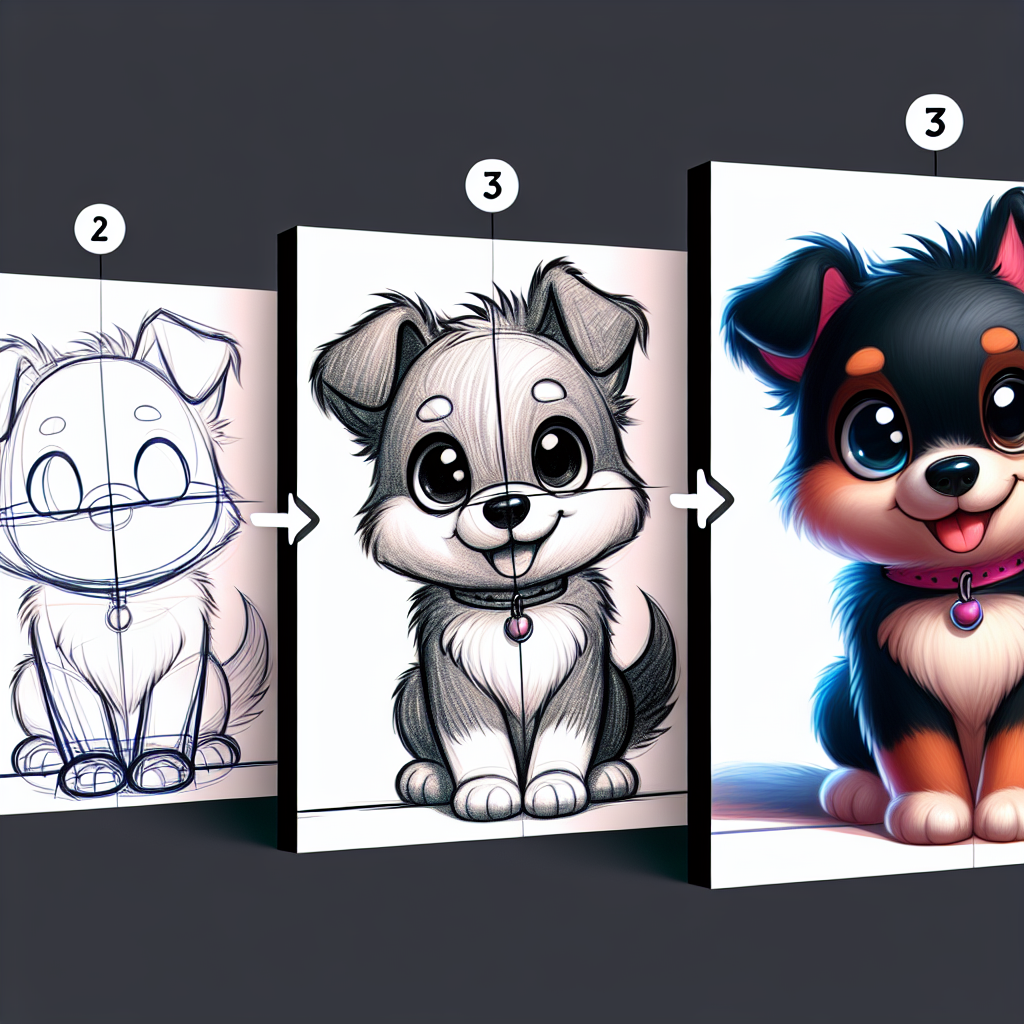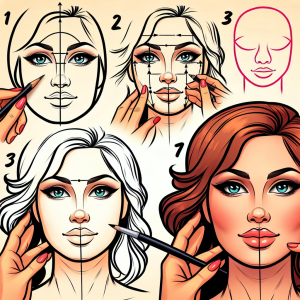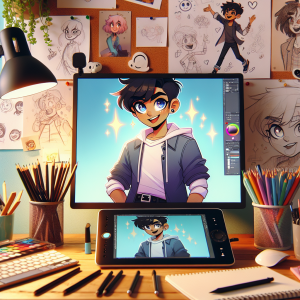Imagine bright, oversized eyes gazing up at you, a playful wagging tail, and an adorable, goofy grin that could melt anyone’s heart. Cartoon dogs have a magical way of bringing joy to our lives, whether they’re the stars of our favorite animated series or the charming characters we doodle in the margins of our notebooks. But how does one go from a simple sketch to a finished drawing of these lovable companions? Join us on an exciting journey as we explore the delightful world of cartoon dog creation!
Finding Inspiration: The Creative Spark
Before putting pencil to paper, the first step is to find inspiration. This can come from anywhere—real-life dogs, classic cartoons, or even your imagination running wild. Start by observing various dog breeds, their unique features, body language, and quirks. Think about what makes them loveable. Is it their floppy ears, their bouncy demeanor, or their endlessly expressive faces? Jot down your ideas in a sketchbook; this is your treasure chest of creativity!
Gathering Reference Images
Once you’ve narrowed down your ideas, it’s time to compile some reference images. Look for photos and illustrations of different dog breeds to inspire your creation. Pay close attention to their variations—some dogs have long snouts and droopy ears, while others are compact and fluffy. Pinterest, Instagram, and art websites are great platforms to find a plethora of images that can help your artistic process. Remember to respect copyright rules and reference them for personal use, or use images that are licensed for reuse.
Sketching the Basics: Starting with Shapes
Now comes the fun part: sketching! Start by drawing the basic shapes that make up your dog. Most cartoon dogs can be broken down into simple geometric forms—ovals, circles, and rectangles. This foundational step will help you establish the overall pose and proportions before diving into details.
1. Draw a large oval for the head.
2. Add a smaller oval for the body.
3. Sketch in circles for paws and curvy lines for the tail.
4. Position the shapes to reflect a playful or relaxed stance.Building Character: Facial Expressions and Features
The face is where your cartoon dog will really come to life. Experiment with different eye shapes, eyebrow angles, and mouth positions. The eyes can be large and round, adding to the cuteness factor, or narrow and mischievous for a more devious dog character. A wagging tongue can evoke playfulness, while floppy ears make your character instantly lovable. Every little change can significantly affect your cartoon dog’s personality!
Refining the Sketch: Adding Details
Once you’re satisfied with the basic shapes and expressions, it’s time to refine your sketch. Add details such as fur texture, distinctive markings, and accessories like collars or bows. Keeping in mind your earlier research, this is where you can blend characteristics from various breeds into your unique creation. Don’t hesitate to exaggerate certain features, as that’s part of the charm of cartooning!
Inking the Outline: Laying Down Clear Lines
With your refined sketch in hand, it’s time to start inking! Use a pen or a digital inking tool to trace over your pencil sketch, emphasizing the lines you want to keep and making smooth curves. This step is crucial because clean lines will help define your character and give it a polished look. If you’re working traditionally, ensure your ink is waterproof if you plan to add color later.
Coloring Your Cartoon Dog: Bringing It to Life
Now comes the moment you’ve been waiting for—adding color! Choose a color palette that reflects the personality of your dog. Bright, vibrant colors can showcase a lively character, while earthy tones can make it appear more grounded and loyal. Use markers or colored pencils for traditional mediums or painting tools in digital software. Don’t be shy about layering colors to create depth and dimension in your cartoon dog!
Shading and Highlights: Adding Depth
To make your cartoon dog pop off the page (or screen), consider adding shading and highlights. Identify the light source in your drawing, and gently darken areas of the fur that would fall into shadow. This creates a three-dimensional effect. Highlights can be added to the eyes and wet areas of the nose and mouth, giving them a lively and realistic touch.
Final Touches: Fine-Tuning Your Masterpiece
After adding color and depth, step back and assess your work. This is the perfect time to make final adjustments—maybe a tweak to the tail for a bit more character or some playful scribbles in the background to convey a scene. Adding a background can set the scene and enhance the overall storytelling of your cartoon dog.
Sharing Your Creation: The Joy of Art
Now that your lovable cartoon dog is complete, it’s time to share it with the world! Post it on social media, submit it to art forums, or keep it for your personal collection. Art is meant to be enjoyed, so don’t hesitate to show off your newfound skills and receive feedback from others. You never know—your cartoon dog might just inspire someone else to pick up a pencil and start creating!
FAQs about Drawing Cartoon Dogs
What supplies do I need to start drawing cartoon dogs?
To get started, you’ll need basic supplies like pencils, erasers, ink pens, colored pencils or markers, and sketch paper. If you prefer digital drawing, a drawing tablet and software like Procreate or Adobe Illustrator will be great tools. It’s all about what you feel comfortable using!
How do I create my own unique cartoon dog character?
Start by combining features you love from various dog breeds, such as ear shape and body type. Experiment with different expressions, poses, and accessories to create a character that feels distinct. Let your imagination guide you, and don’t be afraid to be whimsical!
Can I use photographs of real dogs as references for my cartoon drawing?
Absolutely! Using photographs is an excellent way to understand breed characteristics and anatomy. Just make sure to use them for inspiration and reference, rather than copying them directly. This will help you develop your unique style!
What common mistakes should I avoid when drawing cartoon dogs?
Some common pitfalls include:
- Not paying attention to proportions—remember to keep them playful and exaggerated!
- Being too rigid with shapes—embrace fluidity and creativity.
- Forget to vary line thickness—thicker lines can add emphasis, while thinner lines can yield delicate details.
How can I improve my drawing skills over time?
Practice, practice, practice! Regularly draw not just cartoon dogs, but other subjects too. Consider joining online art communities for feedback, taking classes, and studying tutorials. The more you draw, the better you will become!
Where can I showcase my cartoon dog drawings?
Various platforms exist for showcasing art! You can use social media sites like Instagram and Facebook, create a portfolio website, or contribute to art community websites like DeviantArt and ArtStation. Sharing your work with others can be fulfilling and a fantastic way to network.
Conclusion: Celebrate Your Journey
Creating lovable cartoon dogs is a delightful journey that unfolds from inspiration to completion. There’s something wonderfully rewarding about transforming a simple sketch into a character that inspires smiles and joy. So, grab your supplies, let your creativity roam free, and enjoy the process of bringing your adorable cartoon dogs to life!








+ There are no comments
Add yours